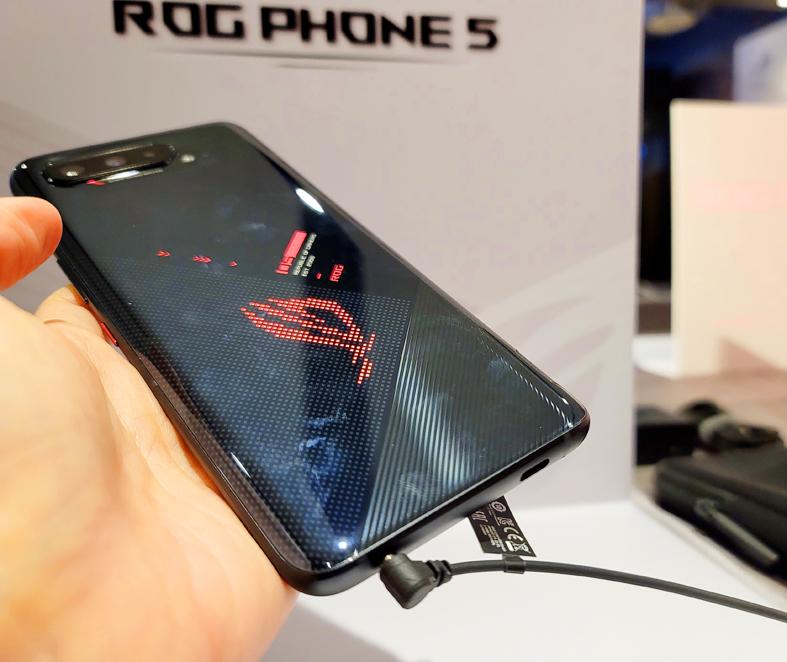Asustek Computer Inc (華碩) has launched the latest in its Republic of Gamers (ROG) smartphone line targeting Android gamers in markets like China.
The ROG Phone 5 maintains the heritage of over-the-top specs and design: Its exterior is decorated with angular motifs and its interior is populated with up to 18GB of memory and Qualcomm Inc’s latest Snapdragon 888 processor.
It has a custom-made 6.8-inch Samsung OLED display, contains two battery cells and is cooled by a vapor chamber system — and its higher-tier models bundle an attachable fan cooler for even more performance.

Photo: Wu Pei-hua, Taipei Times
In the commodified Android device market, Asustek is betting on its brand association with gaming and the broad enthusiasm for a tailored user experience.
The ROG Phone 5 comes with an app providing a console-like interface and the company is working with game makers to add support for the highest refresh rates its display is capable of.
However, to break past its 0.2 percent global market share, the company would need some help, Neil Mawston of Strategy Analytics said.
“Fancy smartphone features are only one leg of a three-leg stool. A top global smartphone vendor today also needs a loud mobile brand plus extensive retail presence — two things that Asus lacks right now,” Mawston said.
Asustek has found success partnering with Chinese Internet giant Tencent Holdings Ltd (騰訊).
The two companies have collaborated on the marketing of ROG phones and certification of games in China for several generations, and the country is one of Asustek’s main focus markets, the company said.
Unlike the PC market, where higher clock speeds and more memory can translate into being able to play at higher fidelity or on larger screens, in the mobile realm practically every company relies on the same basic architecture.
The leading duo of Apple Inc and Samsung Electronics Co consistently tout their devices’ gaming capabilities, pushing brands like Asustek to focus on hardcore gaming fans.
“For these branded gaming phones to grow, vendors will need to heavily invest in e-sports tournaments and have their phones become the official competition phone so that demand can flow from top to bottom,” International Data Corp analyst Liao Yexi said.
“Gaming performance is their top-selling point and hence the target audience has to be both hardcore gamers and professional gamers,” Liao said.
Asustek has seen “big growth” in sales between each successive ROG Phone generation, the company said, and it appears committed to the niche it has carved out.
The ROG Phone 5 starts at 799 euros (US$950) and scales up to 1,299 euros for an Ultimate fan edition with maxed-out memory and storage.

Intel Corp chief executive officer Lip-Bu Tan (陳立武) is expected to meet with Taiwanese suppliers next month in conjunction with the opening of the Computex Taipei trade show, supply chain sources said on Monday. The visit, the first for Tan to Taiwan since assuming his new post last month, would be aimed at enhancing Intel’s ties with suppliers in Taiwan as he attempts to help turn around the struggling US chipmaker, the sources said. Tan is to hold a banquet to celebrate Intel’s 40-year presence in Taiwan before Computex opens on May 20 and invite dozens of Taiwanese suppliers to exchange views

Application-specific integrated circuit designer Faraday Technology Corp (智原) yesterday said that although revenue this quarter would decline 30 percent from last quarter, it retained its full-year forecast of revenue growth of 100 percent. The company attributed the quarterly drop to a slowdown in customers’ production of chips using Faraday’s advanced packaging technology. The company is still confident about its revenue growth this year, given its strong “design-win” — or the projects it won to help customers design their chips, Faraday president Steve Wang (王國雍) told an online earnings conference. “The design-win this year is better than we expected. We believe we will win

Chizuko Kimura has become the first female sushi chef in the world to win a Michelin star, fulfilling a promise she made to her dying husband to continue his legacy. The 54-year-old Japanese chef regained the Michelin star her late husband, Shunei Kimura, won three years ago for their Sushi Shunei restaurant in Paris. For Shunei Kimura, the star was a dream come true. However, the joy was short-lived. He died from cancer just three months later in June 2022. He was 65. The following year, the restaurant in the heart of Montmartre lost its star rating. Chizuko Kimura insisted that the new star is still down

While China’s leaders use their economic and political might to fight US President Donald Trump’s trade war “to the end,” its army of social media soldiers are embarking on a more humorous campaign online. Trump’s tariff blitz has seen Washington and Beijing impose eye-watering duties on imports from the other, fanning a standoff between the economic superpowers that has sparked global recession fears and sent markets into a tailspin. Trump says his policy is a response to years of being “ripped off” by other countries and aims to bring manufacturing to the US, forcing companies to employ US workers. However, China’s online warriors